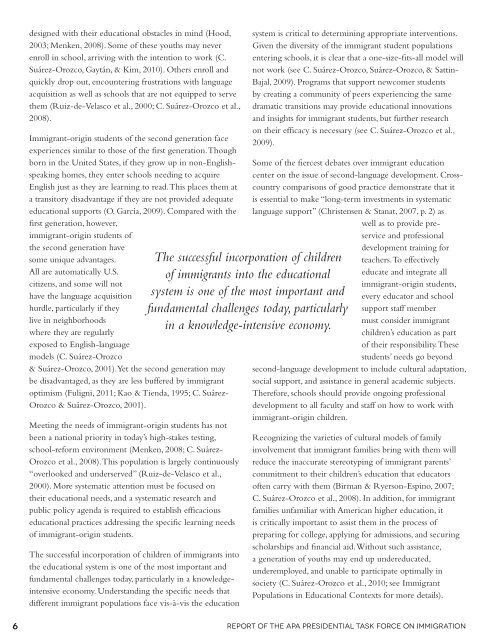Crossroads: The Psychology of Immigration in the New Century
Crossroads: The Psychology of Immigration in the New Century
Crossroads: The Psychology of Immigration in the New Century
You also want an ePaper? Increase the reach of your titles
YUMPU automatically turns print PDFs into web optimized ePapers that Google loves.
designed with <strong>the</strong>ir educational obstacles <strong>in</strong> m<strong>in</strong>d (Hood,<br />
2003; Menken, 2008). Some <strong>of</strong> <strong>the</strong>se youths may never<br />
enroll <strong>in</strong> school, arriv<strong>in</strong>g with <strong>the</strong> <strong>in</strong>tention to work (C.<br />
Suárez-Orozco, Gaytán, & Kim, 2010). O<strong>the</strong>rs enroll and<br />
quickly drop out, encounter<strong>in</strong>g frustrations with language<br />
acquisition as well as schools that are not equipped to serve<br />
<strong>the</strong>m (Ruiz-de-Velasco et al., 2000; C. Suárez-Orozco et al.,<br />
2008).<br />
Immigrant-orig<strong>in</strong> students <strong>of</strong> <strong>the</strong> second generation face<br />
experiences similar to those <strong>of</strong> <strong>the</strong> first generation. Though<br />
born <strong>in</strong> <strong>the</strong> United States, if <strong>the</strong>y grow up <strong>in</strong> non-Englishspeak<strong>in</strong>g<br />
homes, <strong>the</strong>y enter schools need<strong>in</strong>g to acquire<br />
English just as <strong>the</strong>y are learn<strong>in</strong>g to read. This places <strong>the</strong>m at<br />
a transitory disadvantage if <strong>the</strong>y are not provided adequate<br />
educational supports (O. García, 2009). Compared with <strong>the</strong><br />
first generation, however,<br />
immigrant-orig<strong>in</strong> students <strong>of</strong><br />
<strong>the</strong> second generation have<br />
some unique advantages.<br />
All are automatically U.S.<br />
citizens, and some will not<br />
have <strong>the</strong> language acquisition<br />
hurdle, particularly if <strong>the</strong>y<br />
live <strong>in</strong> neighborhoods<br />
where <strong>the</strong>y are regularly<br />
exposed to English-language<br />
models (C. Suárez-Orozco<br />
& Suárez-Orozco, 2001). Yet <strong>the</strong> second generation may<br />
be disadvantaged, as <strong>the</strong>y are less buffered by immigrant<br />
optimism (Fuligni, 2011; Kao & Tienda, 1995; C. Suárez-<br />
Orozco & Suárez-Orozco, 2001).<br />
Meet<strong>in</strong>g <strong>the</strong> needs <strong>of</strong> immigrant-orig<strong>in</strong> students has not<br />
been a national priority <strong>in</strong> today’s high-stakes test<strong>in</strong>g,<br />
school-reform environment (Menken, 2008; C. Suárez-<br />
Orozco et al., 2008). This population is largely cont<strong>in</strong>uously<br />
“overlooked and underserved” (Ruiz-de-Velasco et al.,<br />
2000). More systematic attention must be focused on<br />
<strong>the</strong>ir educational needs, and a systematic research and<br />
public policy agenda is required to establish efficacious<br />
educational practices address<strong>in</strong>g <strong>the</strong> specific learn<strong>in</strong>g needs<br />
<strong>of</strong> immigrant-orig<strong>in</strong> students.<br />
<strong>The</strong> successful <strong>in</strong>corporation <strong>of</strong> children <strong>of</strong> immigrants <strong>in</strong>to<br />
<strong>the</strong> educational system is one <strong>of</strong> <strong>the</strong> most important and<br />
fundamental challenges today, particularly <strong>in</strong> a knowledge<strong>in</strong>tensive<br />
economy. Understand<strong>in</strong>g <strong>the</strong> specific needs that<br />
different immigrant populations face vis-à-vis <strong>the</strong> education<br />
<strong>The</strong> successful <strong>in</strong>corporation <strong>of</strong> children<br />
<strong>of</strong> immigrants <strong>in</strong>to <strong>the</strong> educational<br />
system is one <strong>of</strong> <strong>the</strong> most important and<br />
fundamental challenges today, particularly<br />
<strong>in</strong> a knowledge-<strong>in</strong>tensive economy.<br />
system is critical to determ<strong>in</strong><strong>in</strong>g appropriate <strong>in</strong>terventions.<br />
Given <strong>the</strong> diversity <strong>of</strong> <strong>the</strong> immigrant student populations<br />
enter<strong>in</strong>g schools, it is clear that a one-size-fits-all model will<br />
not work (see C. Suárez-Orozco, Suárez-Orozco, & Satt<strong>in</strong>-<br />
Bajal, 2009). Programs that support newcomer students<br />
by creat<strong>in</strong>g a community <strong>of</strong> peers experienc<strong>in</strong>g <strong>the</strong> same<br />
dramatic transitions may provide educational <strong>in</strong>novations<br />
and <strong>in</strong>sights for immigrant students, but fur<strong>the</strong>r research<br />
on <strong>the</strong>ir efficacy is necessary (see C. Suárez-Orozco et al.,<br />
2009).<br />
Some <strong>of</strong> <strong>the</strong> fiercest debates over immigrant education<br />
center on <strong>the</strong> issue <strong>of</strong> second-language development. Crosscountry<br />
comparisons <strong>of</strong> good practice demonstrate that it<br />
is essential to make “long-term <strong>in</strong>vestments <strong>in</strong> systematic<br />
language support” (Christensen & Stanat, 2007, p. 2) as<br />
well as to provide preservice<br />
and pr<strong>of</strong>essional<br />
development tra<strong>in</strong><strong>in</strong>g for<br />
teachers. To effectively<br />
educate and <strong>in</strong>tegrate all<br />
immigrant-orig<strong>in</strong> students,<br />
every educator and school<br />
support staff member<br />
must consider immigrant<br />
children’s education as part<br />
<strong>of</strong> <strong>the</strong>ir responsibility. <strong>The</strong>se<br />
students’ needs go beyond<br />
second-language development to <strong>in</strong>clude cultural adaptation,<br />
social support, and assistance <strong>in</strong> general academic subjects.<br />
<strong>The</strong>refore, schools should provide ongo<strong>in</strong>g pr<strong>of</strong>essional<br />
development to all faculty and staff on how to work with<br />
immigrant-orig<strong>in</strong> children.<br />
Recogniz<strong>in</strong>g <strong>the</strong> varieties <strong>of</strong> cultural models <strong>of</strong> family<br />
<strong>in</strong>volvement that immigrant families br<strong>in</strong>g with <strong>the</strong>m will<br />
reduce <strong>the</strong> <strong>in</strong>accurate stereotyp<strong>in</strong>g <strong>of</strong> immigrant parents’<br />
commitment to <strong>the</strong>ir children’s education that educators<br />
<strong>of</strong>ten carry with <strong>the</strong>m (Birman & Ryerson-Esp<strong>in</strong>o, 2007;<br />
C. Suárez-Orozco et al., 2008). In addition, for immigrant<br />
families unfamiliar with American higher education, it<br />
is critically important to assist <strong>the</strong>m <strong>in</strong> <strong>the</strong> process <strong>of</strong><br />
prepar<strong>in</strong>g for college, apply<strong>in</strong>g for admissions, and secur<strong>in</strong>g<br />
scholarships and f<strong>in</strong>ancial aid. Without such assistance,<br />
a generation <strong>of</strong> youths may end up undereducated,<br />
underemployed, and unable to participate optimally <strong>in</strong><br />
society (C. Suárez-Orozco et al., 2010; see Immigrant<br />
Populations <strong>in</strong> Educational Contexts for more details).<br />
6 Report <strong>of</strong> <strong>the</strong> APA Presidential Task Force on <strong>Immigration</strong>
















